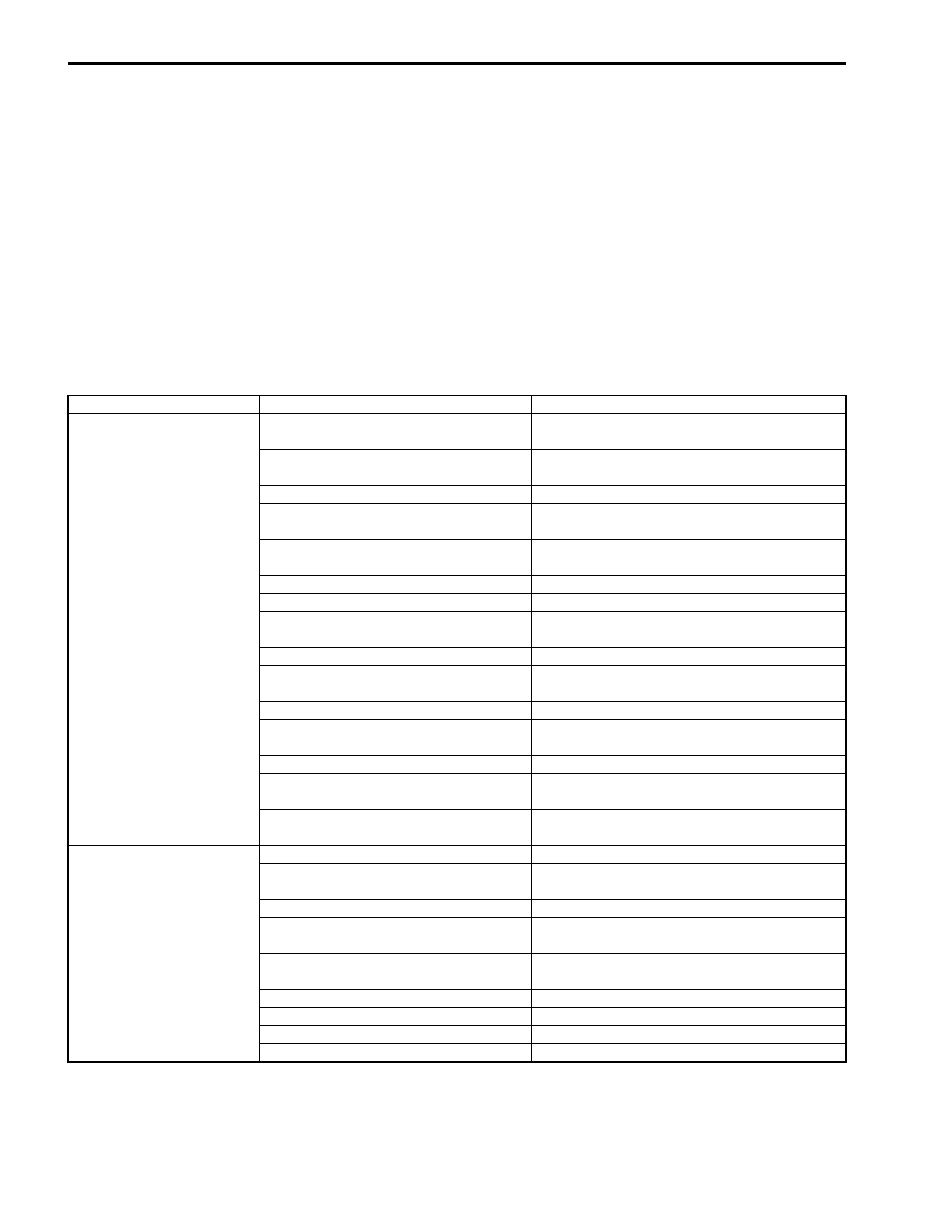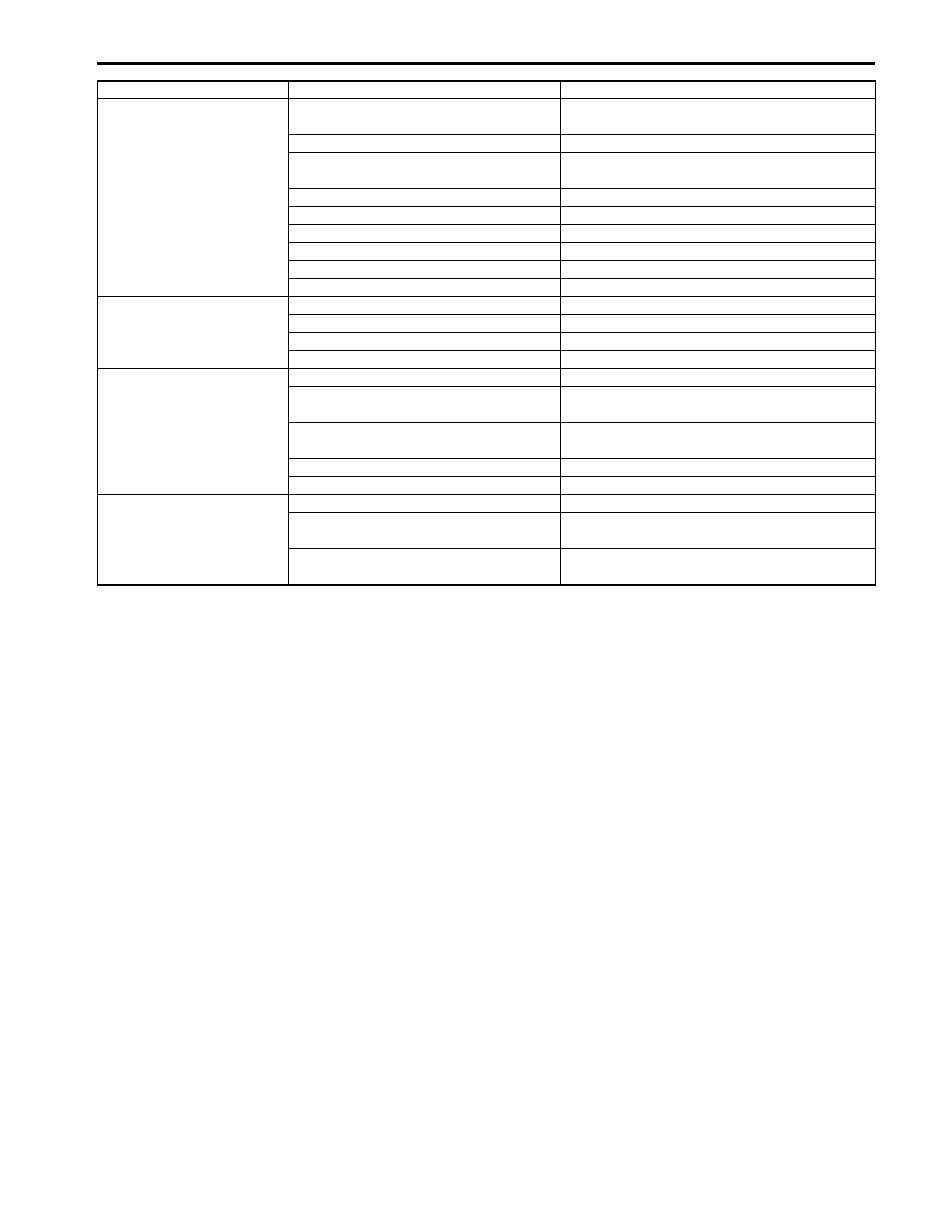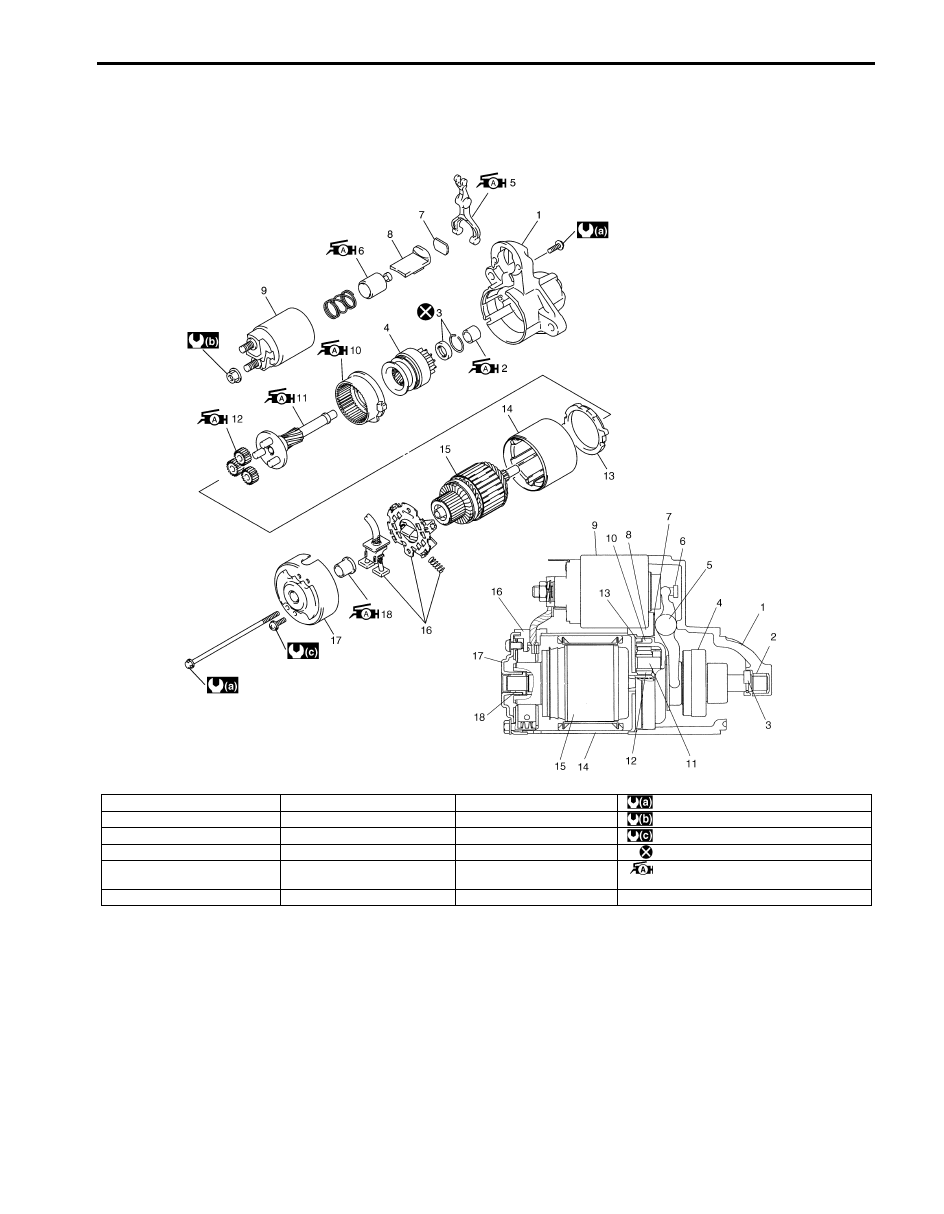Suzuki Grand Vitara JB627. Manual — part 112

1I-2 Starting System:
Diagnostic Information and Procedures
Cranking System Symptom Diagnosis
S6JB0B1904001
Possible symptoms due to starting system trouble would be as follows:
• Starting motor does not run (or runs slowly)
• Starting motor runs but fails to crank engine
• Abnormal noise is heard
Proper diagnosis must be made to determine exactly where the cause of each trouble lies. .in battery, wiring harness,
(including starting motor switch), starting motor or engine.
Do not remove motor just because starting motor does not run. Check the following items and narrow down scope of
possible causes.
1) Condition of trouble
2) Tightness of battery terminals (including ground cable connection on engine side) and starting motor terminals
3) Discharge of battery
4) Mounting of starting motor
Condition
Possible cause
Correction / Reference Item
Motor not running – No
operating sound of
magnetic switch
Shift lever switch is not in P or N, or not
adjusted (A/T)
Shift in P or N, or adjust switch.
Malfunction of clutch pedal position
switch (M/T)
Adjust or replace.
Battery run down
Recharge battery.
Battery voltage too low due to battery
deterioration
Replace battery.
Poor contact in battery terminal
connection
Retighten or replace.
Loose grounding cable connection
Retighten.
Fuse set loose or blown off
Tighten or replace.
Poor contacting action of ignition switch
and magnetic switch
Replace.
Lead wire coupler loose in place
Retighten.
Open-circuit between ignition switch and
magnetic switch
Repair.
Open-circuit in pull-in coil
Replace magnetic switch.
Brushes are seating poorly or worn
down
Repair or replace.
Poor sliding or plunger and/or pinion
Repair.
Faulty starting motor control relay
“Engine and Emission Control System Relay
Inspection in Section 1C”.
Faulty ECM and its circuit
“Inspection of ECM and Its Circuits in Section
1A”.
Motor not running –
Operating sound of
magnetic switch heard
Battery run down
Recharge battery.
Battery voltage too low due to battery
deterioration
Replace battery.
Loose battery cable connections
Retighten.
Burnt main contact point, or poor
contacting action of magnetic switch
Replace magnetic switch.
Brushes are seating poorly or worn
down
Repair or replace.
Weakened brush spring
Replace.
Burnt commutator
Replace armature.
Layer short-circuit of armature
Replace.
Crankshaft rotation obstructed
Repair.

Starting System: 1I-3
Starting motor running,
but too slow (small
torque) – Battery and
wiring are satisfactory
Insufficient contact of magnetic switch
main contacts
Replace magnetic switch.
Layer short-circuit of armature
Replace.
Disconnected, burnt or worn
commutator
Repair commutator or replace armature.
Worn brushes
Replace brush.
Weakened brush springs
Replace brush assembly.
Burnt or abnormally worn end bush
Replace front housing.
Burnt commutator
Replace armature.
Layer short-circuit of armature
Replace.
Crankshaft rotation obstructed
Repair.
Starting motor running,
but not cranking engine
Worn pinion tip
Replace over-running clutch.
Poor sliding of over-running clutch
Repair.
Over-running clutch slipping
Replace over-running clutch.
Worn teeth of ring gear
Replace flywheel (M/T) or drive plate (A/T).
Noise
Abnormally worn bush
Replace front housing.
Worn pinion or worn teeth of ring gear
Replace over-running clutch, flywheel (M/T) or
drive plate (A/T).
Poor sliding of pinion (failure in return
movement)
Repair or replace.
Worn internal or planetary gear teeth
Replace.
Lack of oil in each part
Lubricate.
Starting motor does not
stop running
Fused contact points of magnetic switch Replace magnetic switch.
Short-circuit between turns of magnetic
switch coil (layer short-circuit)
Replace magnetic switch.
Failure of returning action in ignition
switch
Replace.
Condition
Possible cause
Correction / Reference Item

1I-4 Starting System:
Starting Motor Performance Test
S6JB0B1904002
CAUTION
!
Each test must be performed within 3 – 5
seconds to avoid coil from burning.
Pull-In Test
1) Connect battery to magnetic switch as shown.
2) Check that plunger and pinion move outward. If
plunger and pinion don’t move, replace magnetic
switch.
NOTE
Before testing, disconnect lead wire from
terminal “M”.
Hold-In Test
1) While connected as above with plunger out,
disconnect negative lead (2) from terminal “M” (1).
2) Check that plunger and pinion remain out. If plunger
and pinion return inward, replace magnetic switch.
Plunger and Pinion Return Test
1) Disconnect negative lead (1) from switch body (2).
2) Check that plunger and pinion return inward. If
plunger and pinion don’t return, disassemble and
inspect starting motor.
No-Load Performance Test
1) Connect battery and ammeter to starter as shown.
2) Check that starter rotates smoothly and steadily with
pinion moving out. Check that ammeter indicates
specified current.
Specified current (no-load performance test)
90 A MAX. at 11 V
NOTE
Use wires as thick as possible and tighten
each terminal fully.
1. Terminal “S”
2. Terminal “M”
3. Lead wire (switch to motor)
1
3
2
I6JB01190001-02
1
2
I6JB01190002-02
1
2
I6JB01190003-02
A
I6JB01190004-01

Starting System: 1I-5
Repair Instructions
Starting Motor Components
S6JB0B1906001
I6JB01190005-02
1. Front housing
7. Plate
13. Packing
: 6 N
⋅m (0.6 kgf-m, 4.5 lb-ft)
2. Bush
8. Seal rubber
14. Yoke
: 10 N
⋅m (1.0 kgf-m, 7.5 lb-ft)
3. Pinion stop ring
9. Magnetic switch
15. Armature
: 3 N
⋅m (0.3 kgf-m, 2.5 lb-ft)
4. Over-running clutch
10. Internal gear
16. Brush assembly
: Do not reuse.
5. Lever
11. Planetary carrier shaft
17. Rear bracket
: Apply grease 99000-25010 to sliding
surface of each part.
6. Plunger
12. Planetary gear
18. Rear bush

Нет комментариевНе стесняйтесь поделиться с нами вашим ценным мнением.
Текст